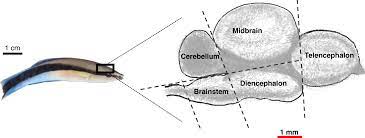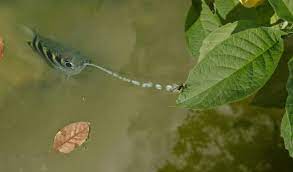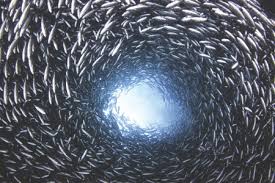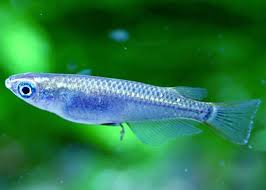Discussion 28: Group Oriented Behavior in Fish
Greetings
This time we will discuss in our review about the evolutionary course of socialization in animals socialization among fish.
First it is said that fish are more intelligent than people think. for example:
Problem solving and use of tools: Some fish have been observed using rocks as tools to open shells. Rainbow fish can adjust the jets of water they spit to knock insects into the water, which accounts for the calculation of refraction.
Memory: Fish have been shown to have fairly good memories. For example, some studies have shown that fish can remember the location of objects, the layout of their environment, and some can learn from past experiences.
Social behavior and communication: Many fish species exhibit complex social behaviors. They can recognize other individual fish, remember them, and can communicate by a variety of means such as sound, visual signals, electrical signals, and chemical signals.
Learning and training: Fish can be trained to perform various tasks. For example, goldfish have been trained to press a lever to obtain food, and they can even learn to do so at certain times of the day.
Spatial navigation: some fish species have impressive spatial navigation abilities. For example, salmon are able to navigate thousands of miles of ocean to return to the stream where they were born when it's time to spawn.
Emotion-like states and pain perception: Fish show behavioral and physiological responses to noxious stimuli, indicating that they can perceive pain. Some researchers claim that fish also show signs of experiencing fear and stress.
These examples illustrate that fish intelligence can be quite complex, although this is of course different from the intelligence of mammals and especially primates. It is also worth noting that there is great variation between fish species, just like there is between mammals, and not all species will display all of the behaviors listed above.
It was documented that the brains of the fish responsible for the behaviors we mentioned above, like the brains of the vertebrates, consist of several separate areas, each of which has a different function. Here is a basic overview of the parts of the fish brain:
1. Olfactory projections: These are located in the front part of the brain and are responsible for processing smells. They are usually larger in species that rely heavily on their sense of smell.
2. Telencephalon: This part of the brain, also called the forebrain, is involved in various functions, including olfactory signal processing, spatial learning, and social behavior. In some fish, it also has a role in processing visual information.
3. Diancephalon: This part of the brain plays a role in visual information processing and regulates hormones and homeostasis. It contains the hypothalamus and the pituitary gland, which are responsible for regulating many bodily functions.
4. Optic tectum (equivalent to superior colliculus in mammals): This part of the midbrain processes visual, auditory and somatosensory information, and is involved in orienting fish towards or away from stimuli. This area tends to be quite large in fish due to their reliance on visual information.
5. The cerebellum: The cerebellum is responsible for motor control and coordination. In fish, it is also involved in processing information about body position and movement.
6. Medulla Oblongata or the elongated brain: this is the lower part of the brain stem. It controls autonomic functions such as breathing, heart rate and digestion.
![Illustrative representation of the fish brain structure. Adapted from [64]. | Download Scientific Diagram](https://joseph-levine.co.il/wp-content/uploads/2023/06/illustrative-representation-of-the-fish-brain-stru-1.jpeg)
Fish brain in a schematic manner

Fish brains are generally smaller and simpler than those of mammals, but there are exceptions. For example, the brains of certain fish species, such as mormyrids and gymnotiforms (which include electric eels), have a relatively large telencephalon due to their ability to generate and interpret electric fields.
Furthermore, fish brains can be quite unique depending on the fish's lifestyle and environment. For example, fish that live in visually complex environments, such as coral reefs, may have more developed visual processing centers, while fish that rely on electrical sensing may have more developed areas for processing electrical signals.
And as mentioned, despite their smaller size and relative simplicity, fish are able to learn and remember, and can exhibit a variety of complex behaviors. They can learn to navigate mazes, recognize other details and even learn from the experience of other fish.
Having friendships and mutual influence between individuals and sometimes also having a hierarchy requires the identification of the individuals in the group. And in discussing the brain structure of fish , the question arises as to which part of the fish's brain recognizes another specific fish. Recognizing other details in fish seems to involve many parts of the brain. While it is difficult to isolate a specific part of the brain responsible for this, it is likely that the process involves many areas working together, as in other vertebrates.
Fish usually recognize each other through a combination of visual, chemical, acoustic or electrical cues, and sometimes even through vibration detection. These cues are processed by different sensory areas of the brain:
1. Visual identification: Fish use visual cues to identify each other, especially those related to body shape, size, color and specific markings. The optic tectum, the part of the brain responsible for visual processing, plays a key role in this. In addition, the telencephalon, also known as the forebrain, can be involved in processing visual information.
2. Chemical recognition: Fish also use pheromones to recognize each other. These chemical signals are processed by the olfactory projections in the forebrain.
3. Acoustic identification: Sound communication in fish, when it exists, is processed in the midbrain and forebrain.
4. Electrical and vibration detection: For fish species that can sense electric fields or vibrations, the relevant sensory data is processed in special areas of the brain.
After processing the sensory data, it is likely that the information is transferred to other areas of the brain (such as the forebrain) where higher-level processing occurs. This can include identifying specific people and recalling previous interactions with them. However, the details of how this process works in fish are not fully understood, and it probably varies between different species.
In terms of other specific fish identification, this will largely depend on the visual identification abilities of the species in question, as well as their reliance on such individual identification in their social interactions.
Much of this visual information will be processed in the optic tectum and possibly also in the telencephalon. But the full understanding of such specific recognition in fish is still an ongoing area of research.
By the way, an interesting point for us humans that has been studied in fish is also whether fish can recognize human faces? Thus studies indicate that certain species of fish can indeed recognize human faces. A study published in 2016 by scientists from the University of Oxford and the University of Queensland [see abstract below] showed that rainbow trout are able to learn and recognize faces with high accuracy.

Rainbow trout
Newport, Cait, Wallis, Guy, & Siebeck, Ulrike E. (2016). "Discrimination of human faces by archerfish (Toxotes chatareus)." Scientific Reports, 6, 27523
In the study, the fish were first trained to spit water at images of human faces displayed on a screen above their aquarium. The fish were then presented with the familiar faces mixed with new ones. The results showed that the fish were able to correctly identify the familiar faces about four-fifths of the time, even when the faces were presented in black and white or with changes in the shape of the head.
However, it is important to note that this does not necessarily mean that all fish can recognize human faces. The ability to recognize and remember details is more common in social species or those that live in complex environments, and it requires a relatively high level of cognitive ability. The rainbowfish's ability to recognize human faces is likely related to its unique hunting strategy, which involves knocking down insects from overhanging vegetation by spitting water at them. This requires the ability to accurately target and remember specific shapes.
While some pet fish owners claim that their fish can detect them, this is mostly anecdotal, and more research will be needed to confirm these observations. However, these studies indicate a higher level of cognitive sophistication in fish than previously assumed.
Communication is necessary for socializing. And in this context demonstrate a variety of communication methods:
1. Visual signals: Many fish use visual cues to communicate. This can include color changes, displays of size or strength, specific body movements, or even the creation of structures such as nests. For example, many male fish change colors during the mating season to attract females.
2. Acoustic signals: Some fish use sound to communicate. These sounds can be produced in different ways, such as by grinding their teeth together, snapping or rubbing their body parts together, or through their swim bladder. These sounds can convey various messages, from attracting a mate to warning others of danger.
3. Chemical signals: Fish can also use chemical signals, or pheromones, to communicate. These chemicals can convey a variety of messages, such as marking territory, signaling readiness to mate or warning of danger. For example, many fish release alarm substances when injured, which can alert nearby fish to the presence of a predator.
4. Electric signals: Certain species of fish, such as electric eels and electric catfish, can generate and sense electric fields. These fields can be used for navigation, hunting and communication. By regulating the frequency and amplitude of their electrical signals, these fish can convey different messages.
5. Tactile signals: Tactile or touch signals are often used in close communication, for example during mating or social contact. Fish may push each other, or even some species may engage in mutual grooming behaviors.
6. Hydrodynamic signals: Certain fish species are sensitive to the water movements created by other fish. This can be especially useful in a fish school, as it helps them stay in sync and keep the right distance from each other.
It is worth noting that not all fish use all of these communication methods, and the details can vary greatly depending on the species and the situation. In addition, many fish are able to use multiple communication methods simultaneously to convey complex information.
All of these, including the ability to identify other fish at different levels and the ability to communicate between fish, allow friendships between many species of fish.
This is how the sociability of fish is expressed in a variety of social behaviors. However, the expression can vary greatly depending on the species. Here are some broad categories of social behavior observed in fish:
1. Schooling: Many species of fish are known for their schooling behavior, where large groups of individuals swim in a coordinated manner. This behavior offers several advantages such as increased protection from predators, better food acquisition efficiency and improved mating opportunities.
2. Territoriality: Some fish are territorial, which means they defend a certain area against other members of the same species, and sometimes also against members of other species. This behavior is often related to the availability of resources such as food or suitable spawning grounds.
3. Hierarchies/Dominance: In some species, fish establish social hierarchies or orders of dominance. This can be related to size, strength or levels of aggression. The most dominant fish usually have access to the best resources, including food and mating opportunities.
4. Parental care: Certain species of fish exhibit parental care, where one or both parents protect and care for their offspring. This characteristic is seen in species such as cichlids and discus fish, where the parents guard their offspring and sometimes even carry them in their mouths for protection.
5. Cooperative behavior: Certain fish species exhibit cooperative behavior, where they work together for mutual benefit. An example of this is the cleaner fish, which cleans parasites from larger fish. The bigger fish gets cleaned, and the cleaner fish gets a meal.
6. Mating Rituals: Many fish species have complex mating rituals that may include displays of color, strength, or nest building. These behaviors are used to attract mates and ensure reproductive success.
7. Communication: Fish communicate with each other in a variety of ways. Some species use visual signals, such as color changes or specific movements. Others may use acoustic signals (voice), chemical signals (pheromones) or even electrical signals.


Fish school with mutual interaction within it
It should be remembered, however, that this is an overview and the social life of fish can be much more complex and varied. For example, some types of cichlids can recognize and remember details, and can form complex systems that depend on the habitat, the availability of resources, or the presence of threats.
Following on from this, we will ask if fish schools have a leader who guides them and directs their movement? In general, fish schools seem to have no single and absolute leader. Many fish species engage in schooling behavior, where a group of fish move together in a synchronized manner. This behavior is believed to provide several benefits, including protection from predators (safety in numbers), increased efficiency in finding food, and higher mating success rates.
The mechanisms behind the behavior in fish schools are complex and not fully understood. It is generally agreed that the movement of a school of fish is the result of distributed decision-making, where each fish adjusts its movements according to the movements of its neighbors. Therefore, the direction of the flock can change according to the actions of each individual fish, not necessarily of a certain leader.
1. However, it is worth mentioning that some studies have found hierarchies or preferred individuals within certain fish species. This can be mistaken for a leadership role, but it's usually more of a social dynamic than a traditional pack-leader setup. For example, African cichlids often establish dominance hierarchies, especially among males.The dominant male usually controls access to food and primary breeding grounds. This male is usually the largest and most colorful individual in the group. However, the hierarchy is often dynamic, with individuals rising or falling in rank.
So, while it's fascinating to see a school of fish moving as if it's a single entity, it's usually not because there's one fish leading the others. Rather, it is a complex and dynamic process driven by the actions of each individual fish within the school.
Finally, below are several abstracts of articles discussing the fascinating topic of facial recognition in fish.
Face recognition in discus fish (Cichlidae): an experimental approach using digital models
Sean Sto, Hirokazu Tanaka, Masanori Kohada. 2016

An example of a discus fish.
Several mammals and birds are known to be able to visually distinguish between familiar and unfamiliar individuals, according to facial patterns. Many fish visually recognize other individuals individually, and previous studies report that facial color patterns can be a primary signal for individual recognition. For example, the discus fish uses specific color patterns that develop only in the facial area. However, it is still unclear whether the facial region is a particularly favorable site for visual signals in fish, and if so why?
The monogamous discus fish, Symphysopdon aequifasciatus (Cichlidae), is able to visually distinguish between its mate and other individuals. Discus fish have specific color patterns throughout their body including the facial area, front head, and vertical fins. If the facial region is an inherently important site for visual cues, this species will use facial patterns for personal identification, but otherwise it will also use patterns on other body parts.
“We used adapted digital models to examine whether discus fish use only facial coloration for personal identification. Digital models of four different combinations of familiar and unfamiliar faces and bodies of fish were presented in frontal and lateral views. The discus fish frequently performed partner-specific behaviors toward partner facial exemplars, and performed aggressive behaviors toward non-partner facial exemplars.”
The authors conclude that in order to identify individuals, this fish does not depend on frontal color patterns but on lateral face color patterns, even though they have unique color patterns on the other body parts as well. The authors discuss the significance of facial color for personal identification in fish compared to birds and mammals.
Facial recognition in a cichlid fish that lives in a group
Masanori Kohada, Lyndon Alexander Jordan, Takashi Hota, Naoya Kosaka, Kenji Karino, Hirokazu Tanaka, Masami Tanayama, Tomohiro Takayama. 2015
Article summary:
The theoretical foundations of socialization mechanisms, such as territoriality, hierarchy and reciprocity, are based on assumptions of personal recognition. While behavioral evidence suggests that individual recognition is common in animals, the cues that animals use to identify individuals are established in only a handful of animal species. The authors use digital models to demonstrate that facial features are the visual cue used for individual recognition in the social fish Neolamprologus pulcher. The fish were exposed to digital images showing four different combinations of familiar and unfamiliar face and body colors.
The fish referred to digital exemplars of unfamiliar faces longer and from a greater distance than to exemplars of familiar faces. These results indicate that these fish can accurately distinguish between individuals using facial color patterns. The observations also indicate that fish are able to distinguish quickly (≤ 0.5 seconds) between familiar and unfamiliar individuals, a recognition speed comparable to primates, including humans.
Personal recognition and the "face reversal effect" in medaka fish (Oryzias latipes)
Mo-Yeon Wang, Hideaki Takauchi. 2017

Article summary:
Personal recognition is essential for maintaining various social interactions in a group, and face recognition is one of the most special cognitive abilities in personal recognition. We used both the mating preference system and the electrical stimulation conditioning experiment to test the ability to detect infrared patterns in madaka, and found that signals in the facial area are important.
Madaka took longer to discriminate vertically inverted faces, but not horizontally inverted faces or inverted non-face objects. The ability can be compared to the classic "face reversal effect" in humans and other mammals.
Additional patterns added to the face did not affect personal identification either. These findings suggest the possibility that the face recognition process may be different from that used for other objects. The complex form of recognition may promote specific processing adaptations, although the mechanisms and neurological bases may be different in mammals and macaques. As a general rule, the ability to recognize other individuals is important for shaping socialization in animals.
Fish focus mainly on the faces of other fish
Takashi Hota, Kento Kawasaki, Sean Sto, Masanori Kohada. 2019
Article summary:
"Face" is a special stimulus in humans, nonhuman primates, and some other social mammals; That is, they perceive the face differently from other body parts and other stimuli. In these species, the face conveys a lot of information, so individuals examine the face at first glance compared to other body parts. Like mammals, the faces of fish also convey a lot of information, but little is known about whether fish pay attention to faces or the viewing patterns of faces. “Here we document the facial vision patterns of the cichlid fish Neolamprologus brichardi, which can distinguish between individuals based on facial colors.
First, we established a method for identifying the point where the fish were examined. Fish often orient their head toward the object of attention, suggesting that the longitudinal axis of the body points to the point of attention. Using this feature, we examined the object of attention of subject fish that were shown photographs of faces and other body parts. The results showed that the fish initially repeatedly checked the face and the duration was longer for the face than for other body parts.”

The cichlid fish Neolamprologus brichardi
Human face recognition by rainbow fish (Toxotes chatareus)
Kate Newport, Guy Wallis, Yerma Rashitnik, Ulrika E. Sibek. 2016
Article summary:
There are two rival theories about how humans recognize faces: (i) recognition is innate, relying on specialized neocortical circuits, and (ii) recognition is an acquired expertise, relying on general object recognition pathways. Here, we investigate whether animals without a neocortex can learn to recognize human faces. Human face recognition has previously been demonstrated for birds, but they are now known to have neocortex-like structures.
Also, most of the work done on domesticated pigeons and the possibility that they have developed adaptations for recognizing human faces cannot be ruled out. Fish do not seem to have neocortex-like brain areas, and given the lack of direct exposure to humans, they likely did not develop special abilities to recognize human faces.
“Using two forced-choice alternatives, we show that rainbow trout (Toxotes chatareus) can learn to discriminate a large number of human face images (Experiment 1, 44 faces), even after controlling for color, face shape, and visual clarity (Experiment 2, 18 faces ). This study not only proves that rainbowfish have impressive pattern discrimination abilities, but also provides evidence that vertebrates that lack a neocortex and have no evolutionary background to distinguish between human faces can nevertheless do so with a high degree of accuracy.”
A species of reef fish uses ultraviolet patterns for facial recognition
Ulrike E. Sibek, Amira Parker, Denis Sprenger, Lydia Metgar, Guy Wallis. 2010.
Article summary:
“The evolutionary and behavioral significance of animal color patterns are still not well understood [1-4], not least patterns that reflect ultraviolet (UV) light [5]. The current belief is that UV signals must be broad and intense to be detected because (1) they tend to be scattered in air and water, (2) when present, the UV-sensitive retinal dyads are usually present in low numbers, and (3) ) usually retinal modulators sensitive to long wavelengths control form vision in the species examined so far [6]. We report on a study of two species of reef fish whose appearance differs only in the fine banded detail of UV-reflective facial patterns.
We show that, contrary to expectations, the reef fish (Pomacentrus amboinensis) is able to use these patterns to differentiate between species. We also discover that the essential features of the patterns are contained precisely in their shape and not in the intensity and shade of their color. The results support the hypothesis that some fish use UV as a high-fidelity "secret communication channel" hidden from predators. In more general terms, the findings help decipher the details of a language of color and pattern long lost to our primate ancestors, but which has been part of the world of many sighted organisms for millions of years.”
Overall, these studies indicate that fish have the ability to recognize and discriminate between faces, which is a complex cognitive task. And finally, current research from this year:
Labroides dimidiatus cleaner fish recognize themselves in a mirror using self-face recognition, just like humans
Masanori Kohada, Raduan Beshari, Naoki Kubo, Satoshi Awata, Will Swersby, Kento Kawasaki, Taiga Kobayashi, Shumpei Sugawa. 2023.
Article summary:
“Some animals have an extraordinary capacity for self-recognition in the mirror, but any implications for self-awareness remain uncertain and controversial. The main reason for this is that explicit tests of the two potential mechanisms underlying mirror self-recognition are still lacking: mental image of the self and kinesthetic visual adaptation. Here, we test the hypothesis that mirror self-recognition in the species Labroides dimidiatus is related to a mental image of the self, specifically the self-face, as in humans. These fish initially attacked photo samples of themselves and unfamiliar strangers.
In contrast, after all fish had passed the mirror-participation test, these fish did not attack their own images (still images), but still frequently attacked those of unfamiliar individuals. When the fish were exposed to complex photographs, their now-unfamiliar self-face/body was not attacked, but images of an unfamiliar self-face/body were attacked, showing that these fish with mirror self-recognition ability recognize their own facial features in the photographs. In addition, when presented with self-photographs with a mark placed on the throat, those cleaner fish that experienced the image in the mirror demonstrated throat-scratching behaviors.
Taken together, our results provide clear evidence that cleaner fish recognize themselves in photographs and that the likely mechanism of mirror self-recognition is related to a mental image of the self-face, rather than a kinesthetic model of visual matching. Humans are also capable of having a mental image of the self-face, which is considered an example of private self-awareness.”

An example of cleaning fish that surround a shark and clean it of various parasites.
We show that combining mirror-test experiments with photographs has enormous potential to advance our understanding of the evolution of cognitive processes and private self-awareness in nonhuman animals.
So much for now in our review about social life in animals during evolution
Best regards
Dr. Igor Salganik and Prof. Joseph Levine
 Prof. Joseph Levine, M.D. is an emeritus associate professor in the Division of Psychiatry, Faculty of Health Sciences, Ben Gurion University in Israel. Prof. Levine is a certified psychiatrist with clinical experience in controlled trials of adult psychiatric disorders and in psychotherapy. He was awarded a NRSAD independent investigator grant for the study of Creatine Monohydrate in psychiatric disorders -- mainly Schizophrenia. He resides and treats patients in Tel Aviv and all of central Israel.
Prof. Joseph Levine, M.D. is an emeritus associate professor in the Division of Psychiatry, Faculty of Health Sciences, Ben Gurion University in Israel. Prof. Levine is a certified psychiatrist with clinical experience in controlled trials of adult psychiatric disorders and in psychotherapy. He was awarded a NRSAD independent investigator grant for the study of Creatine Monohydrate in psychiatric disorders -- mainly Schizophrenia. He resides and treats patients in Tel Aviv and all of central Israel.
Leave a comment